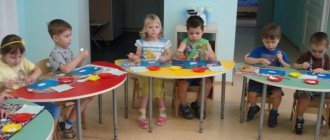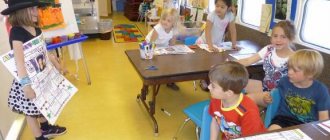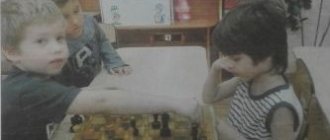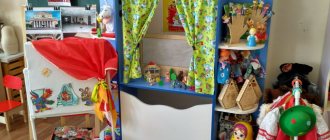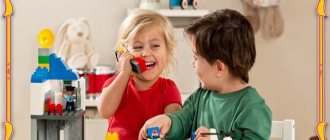Formation of communication abilities in preschool age
Speech is a universal means of communication that helps convey feelings, knowledge, and wishes. Without words, it is difficult to ask for something or communicate your intentions.
However, children, due to their limited age capabilities, are just beginning to master such an important tool.
From the first years of life, a child is focused on communication. He is friendly, smiling, and willing to make contact. But, if until the age of three the baby tries to interact with others, holding on to his mother or father’s hand, then in preschool age he increasingly has to do without the direct support of an adult.
By communicating with each other, children develop and gain new experiences. Some of them are proactive and take a leading position in the game. Others are responding to this initiative and adopting the proposed rules. Still others are observant and adopt those forms of communication that appeal to them.
The development of children's communicative culture is facilitated by the help of educators and parents. Adults support, suggest what is best to do, and also help develop the ability to demonstrate important elements of communication that form the basis of emotional intelligence:
- Sympathy and empathy;
- The ability to imagine what another feels;
- Containing emotions (without screaming, crying and stamping your feet);
- Understanding that each person is individual and may feel differently.
Nonverbal stage of communication
Nonverbal communication is conversation without the use of speech. This form of contact is available at any age. Developmental researchers say that children are capable of perfectly imitating the facial expressions of adults, and are not yet constrained by conventions and norms.
This skill is especially important for establishing contact with peers. In early preschool age, it is quite difficult to get acquainted and come to an agreement with the help of speech, but improvised means come to the rescue.
Playing nearby in the sandbox, a preschooler smiles and invites his new friend to make Easter cakes together. Confirming this proposal is very simple - hold out a spatula or mold. It’s also common for kids to want to show what they can do. Attention is more often attracted by touch, and the sand castle is shown using the hands.
At this stage, it is also easier for preschoolers to express sympathy and antipathy non-verbally. Those they love get hugs and kisses. Adults and children who do not enjoy the baby’s favor may see a frown on their forehead, the child’s back, or even an attempt to hide behind their mother’s skirt.
Communicative-speech stage
As the vocabulary is filled, the development of communication abilities in preschoolers accelerates. Questions arise: “Where?”, “Where?”. The baby adds simple explanations to non-verbal signals inviting communication: “My car,” “Pour sand into the bucket.”
At 4 years old, a child can easily make narrative sentences. Communicating with other children, the preschooler discovers his involvement in the community and joyfully states: “We roll cars,” “We run.”
Five-year-old children are able to invite a peer to play and actively use more complex constructions: “Let’s play shop, I’ll sell, and you’ll buy.”
In the communication of younger preschoolers, there are also conflict situations. For the most part, they are provoked by children's egocentrism. Sometimes a child will never agree to give his toy. On the other hand, there are children who, when they see an attractive car or scoop from another child, want to get it immediately.
In any of these cases, it is important that the adult explains to the child how to ask a friend to share a toy. It is necessary to teach little communicators the accepted polite phrases that regulate communication.
From the age of five, a preschooler, thanks to the development of coherent speech and awareness of the importance of words for communication, moves to a higher level of communication. Communication skills at this stage become especially important.
Communicative activities and pre-verbal forms of communication
The baby understands pointing and prohibiting gestures, and also performs some communicative actions: waves his hand when saying goodbye, imitating an adult, uses a pointing gesture to make a request. At this age, a system of pre-verbal forms of communication is actively developing, which includes sounds (vocalizations), facial expressions, voluntary body movements, gestures and glances (“pointing”, “seeking evaluation”, “connecting”). A delay in the formation or complete absence of the corresponding paralinguistic structures at the end of the first year of life indicates serious violations of the communicative function of speech.
A normally developing child develops an understanding of addressed speech: he responds with action to verbal requests (for example, clapping his hands when hearing the word “okay”), nodding his head as a sign of “agreement-disagreement.” By 12 months, verbal communication appears using the first words, usually denoting close people, a favorite toy, or a frequently performed action.
Cognitive development
The child develops the first visual and effective ideas, which are the sensory-perceptual basis for the formation of generalized thinking and speech in young children. A special form of activity of an infant is imitation (movements, gestures, facial expressions, voice, simple words) of an adult, which becomes conscious and varied at the end of the first year of life.
With severe disorders of psycho-emotional and cognitive development, the following are observed:
- unexpressive and monotonous facial expressions;
- emotional manifestations in the form of chaotic motor activity or oral synkinesis;
- inadequate reactions to speech, verbal instructions, or demonstrated action.
Speech therapy examination
The most important diagnostic parameters for assessing a child’s speech development by the age of 1 year are:
— priority acquisition of the basic pragmatic aspects of human communication
(the baby looks into the eyes of the interlocutor, follows the order of “statements”, nods his head - “agree/disagree”, waves his hand - “goodbye”, etc.);
— good understanding of spoken language
(knows his name, understands simple questions, reacts to prohibitions, follows simple instructions);
— completion of the babbling stage
(active babbling, its intonation coloring and proximity to the expressive melodic-rhythmic features of the speech of adults, the transition from the autolalic stage of babbling to babbling dialogues with mother, imitation of new syllables);
— the appearance of the first words and the transition to speech communication
(in babbling, the first words are distinguished, which are close in structure to babbling; imitation of significant words of adults in the form of several simplified words develops);
— conditions that most influence the activation of a child’s sound/speech activity:
tactile-emotional, emotional-speech, objective-active communication between a child and an adult or a combination of these forms (Yu.A. Razenkova, 1998);
— development of basic swallowing and chewing skills.
It is advisable to conduct a survey of parents and analysis of the results of observation of a child in the first year of life based on the general patterns of development of the infant’s first mental reactions in ontogenesis, their dependence on the formation of motor functions, the child’s somatic health and other factors (for example, characteristics of emotional relationships in the family).
Any violations of the vocal, respiratory or articulatory component of the pronunciation aspect of speech identified in an infant require timely corrective measures, additional examination of the child by other specialists (neurologist, otolaryngologist, audiologist), and difficulties in the formation of communicative activity require consultation with a child psychologist.
Development of communication abilities of older preschoolers
A child who prefers to spend time alone often does so for reasons of inability to be interesting and communicate well. Being among his peers, he may experience shyness, lack of self-confidence, or be aggressive. Therefore, preschool development requires the allocation of a significant amount of time for the formation of communication skills.
The conditions for the development of communication abilities imply two complementary paths. The first is active communication with adults and adopting their communication model and style of communicative behavior. The second is spending time with peers, during which children constantly learn from each other.
With the development of communicative abilities, children of senior preschool age develop stable motives for communication and a desire to interact with both adults and peers.
Borrowing adult communication models
By communicating with adults, a preschooler develops the basic components of communication skills. The ready-made model that they observe among relatives and educators allows them to understand the following:
- When to make contact, that is, to understand under what conditions conversations are appropriate and when to remain silent;
- How to organize communication, how to resolve conflicts, clearly see emotional empathy;
- What norms and rules does communication require, that is, to determine for yourself the boundaries of acceptable harshness, frankness, and playfulness.
Also, dialogues with adults mean obtaining information about knowledge and cultural values. By example, children learn to tell stories, learn how to make their stories interesting and exciting.
Development of abilities in communicating with children
The fundamental difference between communication with peers is increased emotional intensity. In this case, boundaries are removed, and children learn to be sincere and artistic. Their communication includes causeless laughter, antics, loud statements that turn into screaming.
In this way, children experiment, independently looking for ways to attract attention to themselves without the help of adults.
Also in peer communication there may be elements such as:
- Unpredictable combinations of syllables and sounds - attempts to create your own language;
- Lack of rules;
- Having harsh words to help release emotions.
If, when talking with adults, a preschooler asks and listens more, then in conversations with peers he strives to speak out himself, even if this means shouting down others. Moreover, the preschooler expects evaluation or new information from teachers and parents. Just by chatting with friends, he learns to express himself and emotions, express desires, show his mood through words, and even tries to take on leadership functions, demonstrating initiative and trying to manage the rest of the company.
“Development of communication skills and speech in young children”
In addition to such short conversations caused by circumstances, the teacher provides for specially organized planned conversations
which can be individual and collective.
To develop speaking skills, verbal instructions are used.
The teacher gives a sample verbal request, asking the child to repeat it, finding out whether he remembers the phrase. Instructions help reinforce forms of polite speech.
Adult
who has high competence in communication is the most likely
model for a child
. Moreover, he is not just a role model. Perceiving the norms and style of interaction that an adult demonstrates, the child accepts them as natural and builds his own style of communication on their basis. For example, in the game “Let's get acquainted!” An adult, demonstrating an example of speech behavior, changes the structure of the question each time. He addresses one child with the words “What is your name?”, another – “Say your name!”, a third he asks, “What did your parents name you at birth?” or “Are you Olya or Masha?” etc. Following this, the children themselves turn to each other, trying not to repeat what the other child has just said, but to come up with their own version of the question (it is this “search” that acts as a goal for him).
To develop the initial forms of speech, the teacher organizes a joint examination of pictures, children’s drawings, and books
.
Short stories from the teacher can stimulate dialogue on a specific topic.
(what he observed on the tram, what he saw interesting in another kindergarten), which evoke similar memories in the children’s memory.
A very effective technique is to unite children of different ages.
, organizing a visit to another group. Guests ask about the little owners’ toys, books, etc.
In the course of directly organized activities, it is not always possible to create effective motivation for children's speech, which results in low speech activity in children. Children for the most part do not speak out on their own, but only in obedience to the demands of an adult. The question-and-answer form of speech is the most common. Moreover, the adult turns out to be the only interlocutor of the children, which contradicts the psychological nature of the child. The child’s priority is communication with peers. A child’s creative activity manifests itself primarily in play.
. Play and work, transformed into play, taking place in a team, provide extremely favorable conditions for the development of language. Play develops language, and language organizes play. A child playing alone speaks and instinctively uses language as the most advanced means of establishing communication with the environment. The teacher must first adapt the children's play to the interests of their language development. Role-playing games “to the family”, “to kindergarten”, “to the store”, as well as on military topics reinforce speaking skills and introduce professional vocabulary. The teacher should help deepen the content of games with such attributes as telephone, information desk, cash register.

